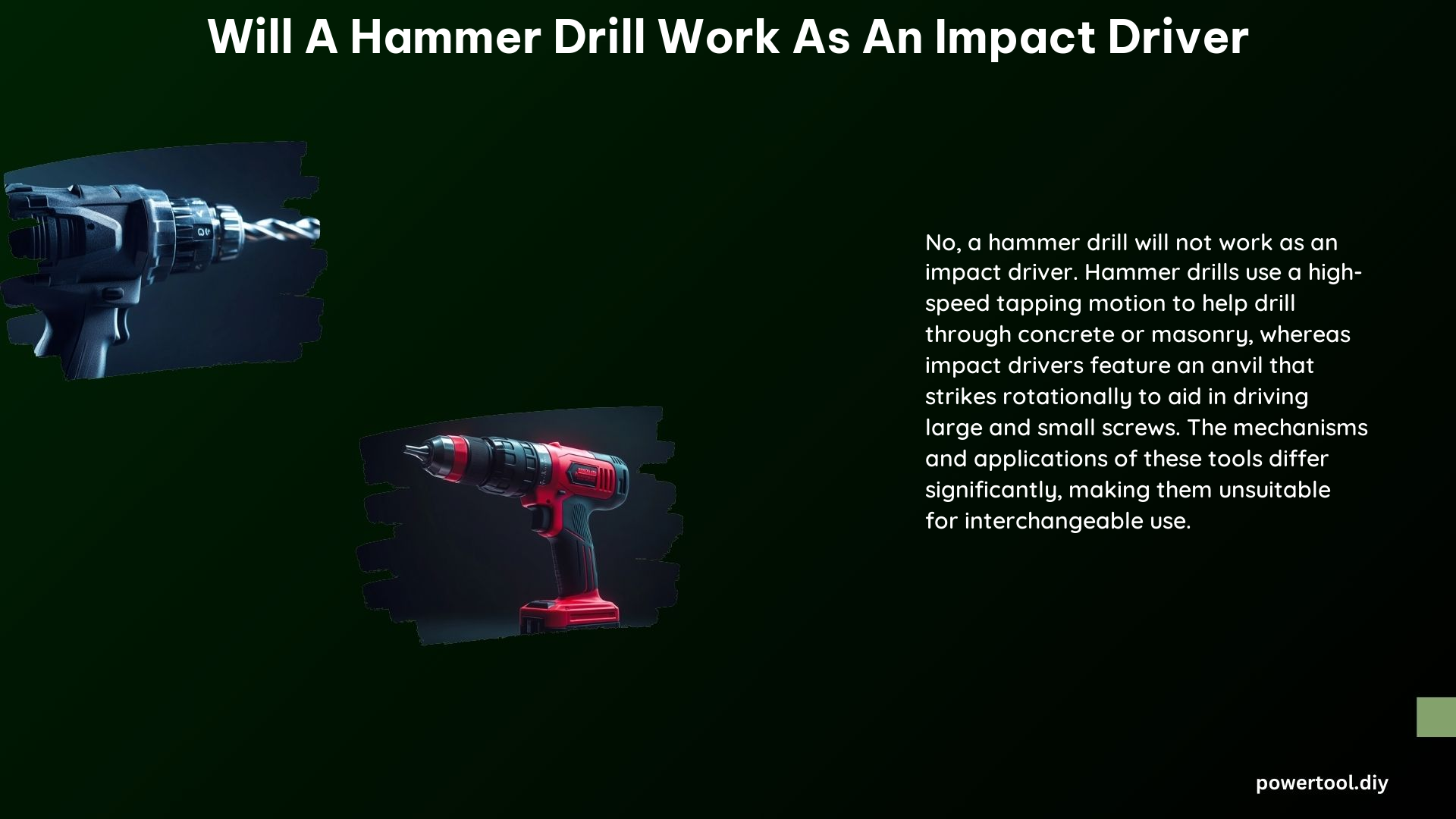Hammer drills and impact drivers are both versatile power tools used for various drilling and fastening tasks, but they have distinct mechanisms and applications. While a hammer drill can be used for some driving tasks, it may not be the most suitable replacement for an impact driver. In this comprehensive guide, we’ll delve into the technical details, key differences, and the potential use of a hammer drill as an impact driver.
Mechanisms: Hammer Drill vs. Impact Driver
Hammer Drill
A hammer drill utilizes a high-speed tapping motion to aid in drilling through concrete, masonry, and other tough materials. This mechanism exerts force directly into the drill bit, similar to someone manually slamming the back of the drill harder into the surface being drilled. The rapid, percussive action of the hammer drill helps to break through the material, making it an excellent choice for tasks such as drilling holes in concrete walls or foundations.
Impact Driver
In contrast, an impact driver features an anvil that strikes rotationally to assist in driving screws, bolts, and other fasteners. This rotational impact mechanism increases the force being delivered perpendicular to the bit, providing greater torque and control when driving fasteners. Impact drivers are particularly useful for driving long ledger screws, lag bolts, and other high-torque applications without causing excessive wrist strain.
Applications: Hammer Drill vs. Impact Driver

Hammer Drill Applications
Hammer drills excel at drilling through concrete, masonry, and other hard materials. They are also suitable for light-duty drilling tasks in wood or metal, as well as driving screws into softer materials. The hammer action of these drills helps to overcome the resistance encountered when drilling through dense, abrasive surfaces.
Impact Driver Applications
Impact drivers are designed for high-torque applications, such as driving screws of all kinds, including wood screws, drywall screws, and hex bolts. They are particularly useful for driving long fasteners, such as ledger screws, without causing wrist fatigue. The rotational impact mechanism of an impact driver allows for efficient and controlled fastener installation, making it a valuable tool for construction, woodworking, and automotive repair tasks.
Key Differences: Hammer Drill vs. Impact Driver
- Direction of Force:
- Hammer Drill: Applies force directly into the drill bit.
-
Impact Driver: Applies force perpendicular to the bit.
-
Torque and Control:
- Hammer Drill: Provides moderate torque and control, suitable for light-duty driving tasks.
-
Impact Driver: Offers significantly higher torque and control, making it more efficient for driving large fasteners.
-
Bit Compatibility:
- Hammer Drill: Can use a wide range of drill bits, including hole saws, self-feed bits, and auger bits.
- Impact Driver: Designed for use with hex shank bits, which are specifically engineered for impact applications.
Can a Hammer Drill Work as an Impact Driver?
While a hammer drill can be used for some driving tasks, it is not an ideal replacement for an impact driver. Hammer drills are primarily designed for drilling through hard materials, and their mechanism is not optimized for high-torque fastener driving applications.
Compared to an impact driver, a hammer drill may not provide the same level of torque and control when driving screws and bolts. The direct, percussive force of a hammer drill can sometimes strip or damage the heads of fasteners, especially when dealing with larger or harder materials.
Technical Specifications: Hammer Drill vs. Impact Driver
To better understand the capabilities of these tools, let’s compare the technical specifications of a high-end model from a leading manufacturer, the Milwaukee FUEL series:
| Specification | Milwaukee FUEL Hammer Drill | Milwaukee FUEL Impact Driver |
|---|---|---|
| Torque | 1,200 in-lbs | 1,800 in-lbs |
| No-Load Speed | 0-1,800 RPM | 0-2,900 RPM |
| Blows per Minute (BPM) | 0-28,800 BPM | 0-4,000 IPM (Impacts per Minute) |
As you can see, the impact driver offers significantly higher torque and a faster no-load speed, which are crucial for efficient and controlled fastener driving. The impact mechanism of the driver also delivers a higher number of impacts per minute, further enhancing its performance in high-torque applications.
Conclusion
In summary, while a hammer drill can be used for some driving tasks, it is not an ideal replacement for an impact driver. Hammer drills are primarily designed for drilling through hard materials, such as concrete and masonry, and their mechanism is not optimized for high-torque fastener driving applications.
Impact drivers, on the other hand, are specifically engineered for efficient and controlled driving of screws, bolts, and other fasteners. They offer significantly higher torque, faster speeds, and a specialized impact mechanism that makes them the better choice for tasks that require powerful and precise fastener installation.
If you need to drive screws and bolts efficiently, an impact driver is the better tool for the job. If your primary focus is drilling through concrete or masonry, a hammer drill is the more suitable option. Understanding the distinct mechanisms and applications of these power tools will help you make an informed decision and select the right tool for your specific needs.
References:
– Pro Tool Reviews. (2020). Hammer Drill VS Impact Driver | What’s The Difference? – YouTube. Retrieved from https://www.youtube.com/watch?v=F1B56OK__R8
– The Wood Whisperer. (n.d.). Drills vs Hammer Drills vs Impact Drivers. Retrieved from https://thewoodwhisperer.com/articles/drills-vs-hammer-drills-vs-impact-drivers/
– Pro Tool Reviews. (n.d.). Impact Driver vs Hammer Drill – What’s the Difference? Retrieved from https://www.protoolreviews.com/impact-driver-vs-hammer-drill/
– HowStuffWorks. (2011). What’s the difference between a hammer drill and an impact driver? Retrieved from https://home.howstuffworks.com/difference-between-hammer-drill-and-impact-driver.htm
– Reddit. (2023). Can you use a hammer drill instead of an impact wrench. Retrieved from https://www.reddit.com/r/Machinists/comments/13mq66w/can_you_use_a_hammer_drill_instead_of_an_impact/
